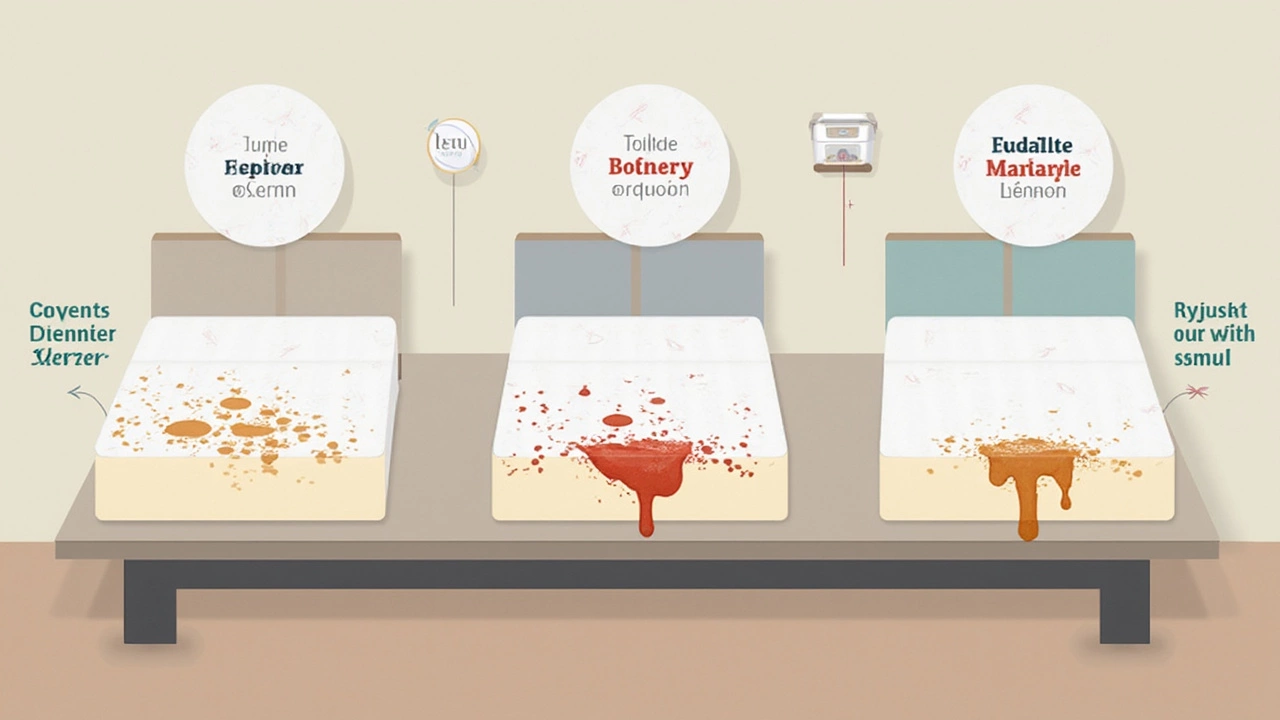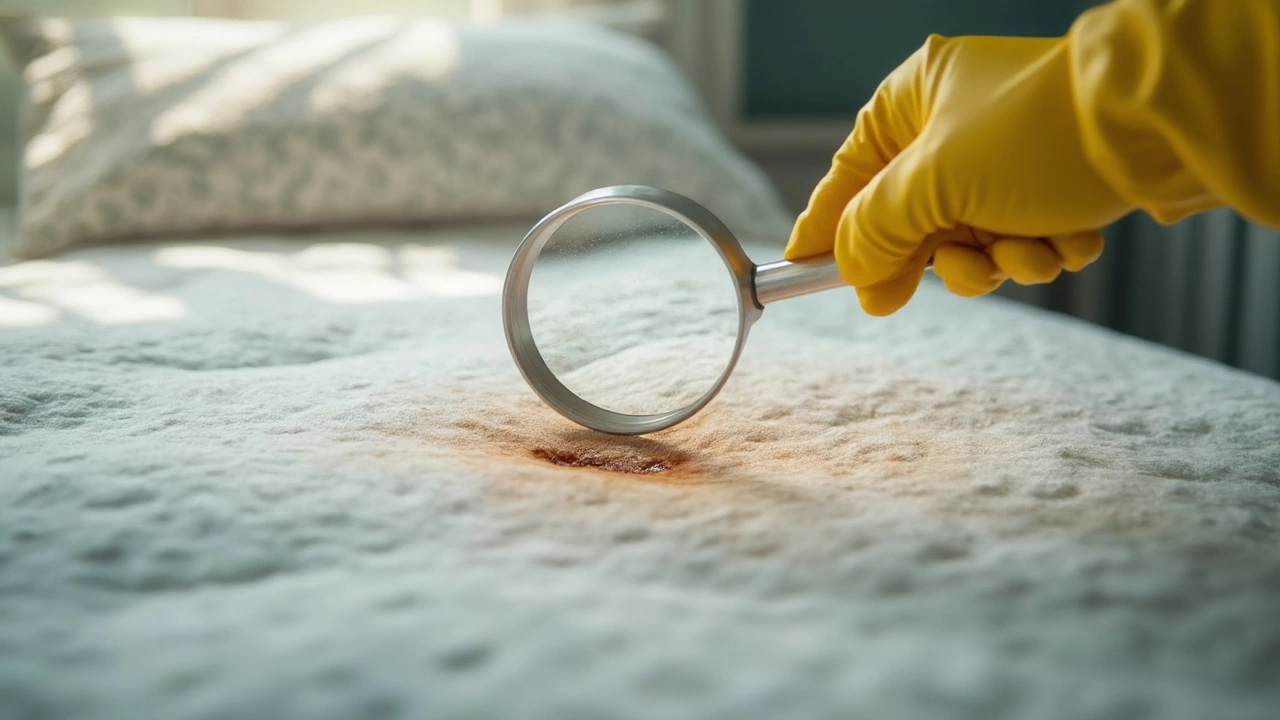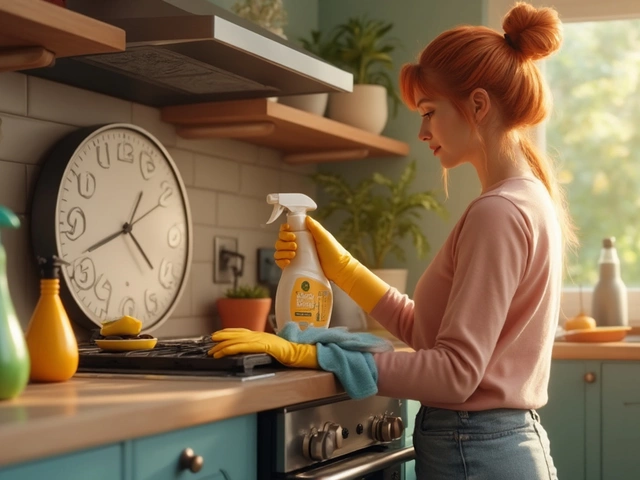There’s nothing like discovering a mysterious stain on your mattress to raise some awkward questions. Is it sperm? Is it discharge? Most people just want a quick way to know what they’re dealing with so they can clean it up and move on. Honestly, it’s not always obvious—these stains can look a lot alike once they dry. But there are some clues you can pick up fast without needing a microscope or chemistry set.
Fresh sperm stains usually start out a cloudy white or slightly gray and, as they dry, tend to harden and turn a yellowish color. In comparison, vaginal discharge stains can range from pale yellow to off-white and may stay soft or even sticky, depending on when you spot them. Give it a sniff (seriously, just for a second)—sperm has a slightly bleachy, chemical smell, while discharge doesn’t get as strong or sharp, unless there’s an infection (in which case, call a doctor, not just a cleaner).
- Spotting the Difference: Sperm vs Discharge Stains
- DIY Tests and Tricks You Can Try
- Cleaning Methods That Actually Work
- Things You Should Never Do to a Stain
Spotting the Difference: Sperm vs Discharge Stains
Figuring out if a spot on your mattress is sperm or vaginal discharge sounds awkward, but knowing the difference can make life easier—especially if you care about cleaning and hygiene. Here’s what you need to look for if you’re caught in this situation.
The first clue is color and texture. Sperm stains hit the mattress usually as cloudy white or slightly grey, but once they dry, they turn yellowish and can crust up. Think of the way egg whites look after they dry on a plate—pretty similar idea. Discharge stains are more varied. They can be yellow, creamy, even a little clear or sticky, depending on the time of the month and health. If the stain stays tacky or doesn’t harden, it’s more likely to be discharge.
Smell is another big giveaway. Sperm stains have a bleachy or chlorine-like scent, especially when fresh. People usually recognize it right away. Discharge, on the other hand, isn’t as sharp. Unless there’s an infection (which has its own strong smell, but that’s a medical thing), discharge smells pretty neutral to faintly sweet or just ‘skin-like’.
- Mattress cleaning is easier if you ID the stain quickly—dried sperm can set more stubbornly than discharge.
- Spot size can help, too. Sperm stains are usually smaller, while discharge stains can be bigger, especially overnight.
- If you scrape the surface gently with a fingernail (yeah, it’s gross), sperm gets hard and flaky; discharge feels stickier or just damp.
| Stain Type | Color (Fresh) | Color (Dry) | Texture | Odor |
|---|---|---|---|---|
| Sperm | Cloudy white/grey | Yellowish, crusty | Hard, flaky | Bleachy/chlorine-like |
| Discharge | Off-white/yellow/clear | Pale yellow, sticky | Sticky, soft | Neutral to faint, rarely sharp |
Also, sperm stains often fade faster on mattresses than discharge. If you see a yellow ring or a flaky patch that wasn’t there last week, sperm is the likely culprit. Discharge stains, on the other hand, hang around and blend into mattress fabrics unless you spot clean them.
Long story short: check the color, feel the surface, and (if you dare) give the spot a quick sniff. That’s about as scientific as you can get in your bedroom without a lab kit.
DIY Tests and Tricks You Can Try
Now you’re staring down a mattress stain, wondering, “What next?” Before you panic or break out the bleach, check out a few real tricks you can use at home to figure out what you’re up against. There’s no need for fancy gadgets—you just need your eyes, nose, and a couple of things you probably already have at home.
Mattress cleaning experts often start by checking texture. Put on some disposable gloves, grab a tissue, and dab at the stain. Sperm stains usually dry crusty and flaky. Discharge tends to stay tacky or mushy, even when dry. This might feel weird to do, but it’s the most hands-on way to check.
- Color test: Wet a cotton swab with a few drops of water and gently rub it on the edge of the stain. Sperm will usually rehydrate, become slightly sticky or gelatinous, and turn a little more transparent. Discharge may dissolve but stays creamier and less sticky.
- Smell test: Don't linger! If you sniff and get a whiff like old chlorine or laundry detergent, you're likely dealing with sperm. If there's not much smell, or a faint musk, it's probably discharge.
- UV Light Test: Got a cheap phone UV flashlight? Sperm lights up bright white or blue under UV, while most types of discharge don’t react much at all. You can snag a pocket UV flashlight online for about $10 if you're dealing with mystery stains a lot (no shame!).
Here’s an easy breakdown of what you can look for at a glance:
| Test | Sperm | Discharge |
|---|---|---|
| Texture | Crusty, hard, flakes | Soft, sticky, creamy |
| Color (dry) | Pale yellow, off-white | Yellowish, off-white to clear |
| Smell | Bleachy, chemical | Faint, musky, usually mild |
| UV Light | Glows bright white/blue | Usually no glow |
A cleaning pro once said,
"A cheap blacklight is the single best tool for finding and identifying questionable stains—especially on mattresses and hotel sheets." – Mark Anderson, Certified Cleaning Technician
If you want to play it extra safe, take a quick picture before cleaning. That way, if you’re ever worried it might be something else (like a spill you forgot about), you can compare later. And remember, no test is 100%, but most of the time, these tricks are all you need to figure out which cleaning method to use next.

Cleaning Methods That Actually Work
So, you found a stain and you know what type you’re dealing with. The next step? Get it out fast, because the longer it sits, the tougher it gets. Most mattress cleaning pros agree: hitting a stain early makes a huge difference—fresh stains can be removed almost 80% more easily than old ones, according to a 2023 survey by Clean Living Magazine.
Here’s what works for both stains:
- First, blot, don’t rub. Use a dry, clean cloth or paper towel to press onto the stain—this soaks up any wetness without spreading it.
- Mix a solution of mild dish soap (just a drop or two) in one cup of cold water. Hot water can "cook" bodily fluids into fabric, making the stain set.
- Dip a cloth in your soapy water and gently dab the stain. Work from the outside in, so the spot doesn’t grow.
- Once the spot looks lighter, switch to a clean damp cloth (just water, no soap) and blot to remove any soap left in the fabric.
- Air-dry the area as quickly as possible—a fan or an open window helps. This stops weird smells from setting in.
If you’re dealing with a mattress cleaning emergency days later, reach for hydrogen peroxide (3%). Pour a tiny bit onto the dried stain, let it fizz for a minute or two, then blot it up gently. Just check a hidden spot on your mattress first, in case it messes with the color.
Enzyme cleaners, sold in pet stores and online, are also a game-changer. They break down proteins in bodily fluids, making them effective against both sperm and discharge stains.
| Stain Type | Best Cleaner | Notes |
|---|---|---|
| Sperm | Hydrogen peroxide, enzyme cleaner | Hydrogen peroxide can bleach fabric—test first |
| Discharge | Dish soap, enzyme cleaner | Usually no bleaching needed; enzyme spray works well |
Avoid bleach unless you’re fine risking yellow spots or damage. And never soak your mattress—too much water leads to mold. Quick tip: For lingering smells, sprinkle baking soda over the spot after cleaning, give it an hour, then vacuum it up. Easy win for fresher beds.
Things You Should Never Do to a Stain
Some folks just grab whatever’s handy and start scrubbing away, but a few bad moves can make a mattress cleaning job way worse. Certain habits will set stains forever, ruin mattress fabric, or just spread the mess around.
- Don’t use hot water right away. Sperm and discharge are protein stains—hot water actually cooks the proteins, making them stick deeper into the fabric. Always go for cold water first.
- No scrubbing with brushes. Tough scrubbing frays mattress fibers and pushes proteins even further in. Gentle blotting with a towel or soft rag does a better job and keeps the mattress looking decent.
- Skip bleach and strong chemicals. Not only can they break down the mattress material and mess up any memory foam, but they also create fumes you don’t want to breathe in while sleeping. Bleach especially should be nowhere near where you rest your head nightly.
- Don’t wait too long. The longer you leave a stain, the more it settles in. Protein stains start bonding to fabrics within hours. Statistically, treating stains within 15 minutes makes complete removal almost twice as likely.
- No hairdryers or heat guns. Heat will do the same thing as hot water and just cook the proteins, turning a fresh stain into a permanent fixture.
- Never soak the mattress. You might think more water helps, but mattresses trap moisture. This sets you up for mold and more stubborn odors down the line.
If you’re wondering just how risky some cleaning mistakes are, take a look at some common bad moves and their side effects:
| Mistake | Likely Outcome |
|---|---|
| Hot Water | Stain gets worse, more permanent |
| Bleach | Discolored patches, weakened fabric |
| Excess moisture | Mold risk jumps 35%, lingering odors |
| Scrubbing | Stain spreads, fabric gets damaged |
The trick is to act fast, use gentle methods, and treat stains like you would your favorite shirt—not like you’re cleaning up an oil spill.





